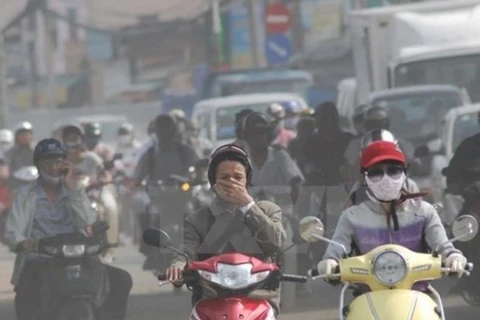Hanoi (VNA) – A “backbone” system in air quality monitoring will be designed in a bid to set up constant air quality monitoring stations in Vietnam’s major cities for prompt warning, according to the Ministry of Natural Resources and Environment (MoNRE).
The MoNRE said it will devise a synchronous “backbone” system in air quality monitoring across all the provinces and cities nationwide, which will display real-time air quality index. The ministry will also launch a mobile application to promptly send warnings to citizens.
At a recent regular conference, Deputy Director General of the Vietnam Environment Administration (VEA) Hoang Van Thuc said the Government has asked the MoNRE to plan the monitoring system to 2025, with a view to 2030.
Accordingly, the MoNRE will design a “backbone” system in air quality monitoring system, as its stations will be installed in large cities, linked with a number of electrochemical workstations and stations of departments of natural resources and environment in respective localities.
In Hanoi alone, there will be additional 20 air quality monitoring stations from now to 2020, including 10 fixed ones.
In the coming time, major urban areas in Vietnam will have enough data to issue timely warnings to local residents, Thuc said.
The official added that recently, foreign organisations such as AirVisual assessed air quality in Hanoi only with data from a station on Au Co road in Nhat Tan ward of Tay Ho district. Therefore, their evaluation could not reflect air quality across the whole city.
The most trustworthy and accurate statistics must be from various monitoring stations, he stressed. In Hanoi, there are two owned by the MoNRE, two of the local authorities, along with several automatic stations.
Each location will generate different results due to various factors, such as traffic density and construction projects, to name a few.
Therefore, air quality assessment in major cities like Hanoi and Ho Chi Minh City should be based on data from various and automatic monitoring stations, Thuc noted.
The official also recommend that people access official websites of the VEA’s Centre for Environmental Measurement or the Hanoi Environmental Protection Agency under the municipal Department of Natural Resources and Environment, among others, to keep watch on every day’s air quality.
Since the end of 2018, the MonRE has announced annual air quality index via the VEA’s monitoring portal, while Hanoi has revealed the data at the municipal Department of Natural Resources and Environment’s portal, as well as in the city’s weather forecasts.
The ministry is set to unveil a report reviewing a national master plan on air quality control later this year.
Rapidly growing population and urbanisation have resulted in severe pollution in Hanoi.
The levels of PM2.5, a single particle with a diameter of less than 2.5 micrometres, exceeded the limits for several days since mid-September, and increased sharply as compared with the previous months and the 2015-2018 period, according to statistics released by the VEA.
Many agencies and organisations have implemented solutions to improve air quality in Hanoi, while promoting the communication and education work at schools and among the community in order to raise public awareness of air quality and necessary actions.
Hanoi consumes an estimated amount of over 400 million kWh of electricity and millions of litres of petrol each day, which results in air pollution and greenhouse gas emission.
This year, the capital city has established and operated 10 automatic air monitoring stations, and built a project on an environment monitoring system with 20 fixed, 12 sensors and one mobile monitoring station.
The city is also working to end the use of coal stoves by the end of next year and embarking on a project on strengthening the management of road vehicles to ease traffic congestion and prevent environment protection for the 2017 – 2020 period with a vision to 2030, and another on noise and dust reduction./.
























